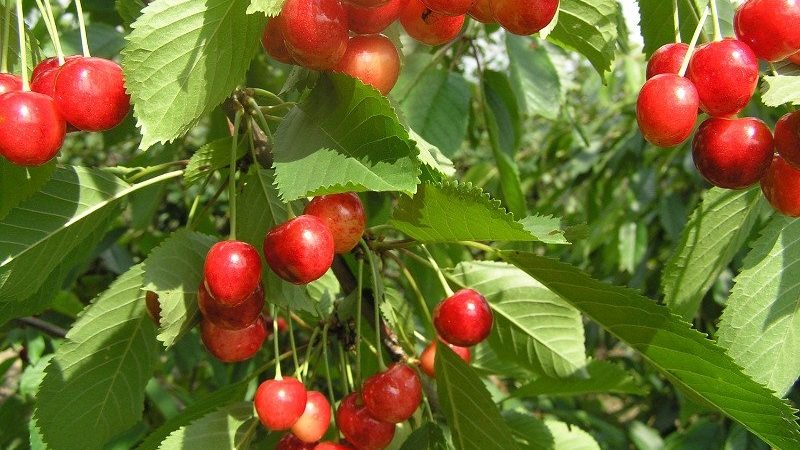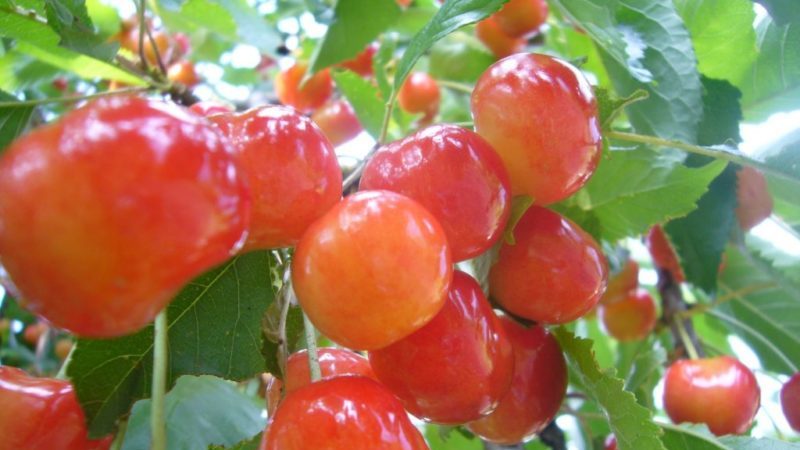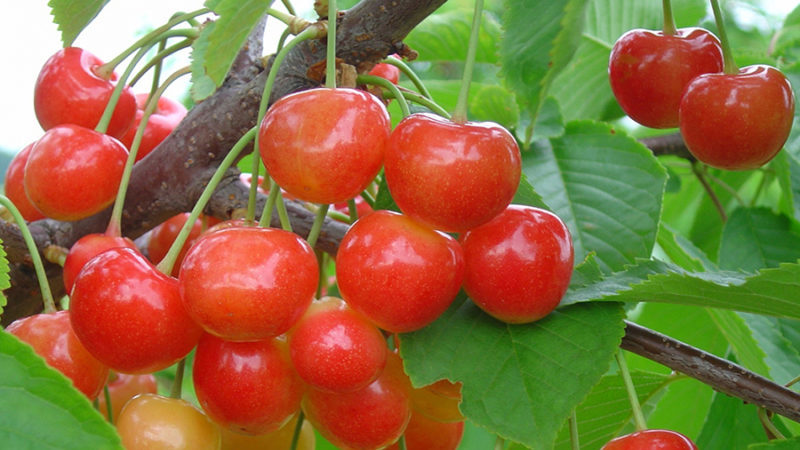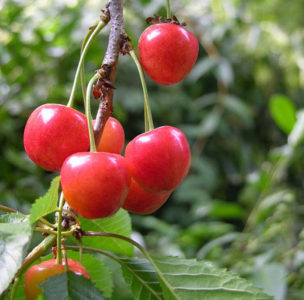Fatezh cherry variety suitable for cultivation in Central Russia
Cherry Fatezh is adapted to the climate of Central Russia. One of its main advantages is frost resistance up to -27 ° С. Medium-sized, compact trees withstand drought and sudden changes in weather without losing yield. The berries do not crack from rain. We will tell you how to choose seedlings and grow Fatezh on your site. Tips on agricultural techniques, taking into account the peculiarities of the culture, are useful for novice and experienced gardeners.
The content of the article
Description of the cherry variety Fatezh

Fatezh - hardy, a self-fertile variety with an average ripening period. Named after the eponymous city of the Kursk region.
Obtained in 1999 from the Leningradskaya yellow cherry. Authors - Evstratov A.I. and Enikeev Kh.K. Tests on the regionalization of culture were carried out for two years. In 2001, Fatezh was included in the State Register for the Central and Northwest Regions. The originator of the variety is the All-Russian Institute of Selection and Technology of Horticulture and Nursery.
Characteristics and description of trees
A tree from the group of medium-sized. The crown is spherical with moderate density. Branches extend from the trunk at right angles. With age and under the weight of the crop, they droop, forming an obtuse angle. The average height of the tree is 3.5 m, the maximum is 5 m. It bears fruit since the fifth year.
The leaves are dark green, large, smooth, lanceolate with finely serrated edges.
The flowers are white, with wide corollas and long stamens, gathered on bouquet branches. Blossom together with young foliage.
Resistant to temperatures
The winter hardiness of flower buds is lower than that of a tree. At a temperature of -27 ° C, the wood does not freeze, and some of the buds are damaged.
Reference. Fatezh has a strong regenerative ability. In case of freezing of wood, maximum productivity returns after 2 years.
Moisture and drought resistance
The variety is adapted to different climatic conditions. Abrupt weather changes and temperature drops do not affect the yield. Trees tolerate drought, but the juiciness of the fruit depends on watering. Frequent waterlogging in flooded lowlands and the proximity of groundwater (up to 1.5 m) lead to decay of the roots.
Disease and pest resistance
The variety has immunity to moniliosis and coccomycosis, resistance to fungal diseases and the main pests of the crop. Trees are affected by gummosis (gum flow).
Characteristics and description of berries

Fruits are one-dimensional, rounded... Located on short, annual shoulder straps. Average weight - 4-6 g. Ripe yellow-orange berries. Sweet and sour to taste, dessert. The pulp is pink, juicy, dense and gristly. The stone is small, oval, easily and cleanly detached. Cherry-floral aroma is pronounced.
The yield in the first year of fruiting is up to 5 kg per tree, in subsequent years - 10-15 kg. The productivity of mature trees (over 10 years old) is from 30 to 50 kg. Harvested in late June - early July.
At a temperature of + 1 ... 0 ° C, fresh berries with petioles are stored for about 10 days. Transferred transportation without losing presentation. Taking into account the long haulage, they are harvested a week before biological ripeness.For conservation - 3 days before ripening.
Read also:
Stable and productive sweet cherry Valery Chkalov.
Weather-resistant sweet cherry variety Vasilisa with large and tasty berries.
A young, but gaining popularity among gardeners variety of cherries Revna.
Areas of use
Fruit of universal use. Thanks to the sweet, crunchy pulp with a refreshing sourness, they are good fresh. They do not crack or lose their shape during heat treatment. They give a lot of juice, a pleasant pink color and a rich aroma. They are dried, frozen, canned, preserves, jams, compotes and candied fruits are prepared.
Advantages and disadvantages of the variety

Variety advantages:
- the compactness of the tree makes harvesting easier;
- frost resistance and drought resistance;
- immunity to moniliosis and coccomycosis;
- high yields and preservation of productivity in any weather;
- one-dimensionality, dessert taste and transportability of fruits.
Disadvantages:
- vulnerability to gommosis;
- sensitivity to soil and waterlogging;
- self-infertility.
Growing technology
The cultivation technique begins with the selection of high-quality planting material, a suitable site and the method of planting a seedling. At the stage of crop care, the main emphasis is on crown formation, treatment of the root circle and prevention of diseases.
Optimal conditions
Sweet cherries grow only in light, well-drained soil with good aeration. Suitable soils are sandy loam and loam with neutral or slightly alkaline acidity. The permissible proximity of groundwater is 1.5 m. Trees are not planted in lowlands - stagnation of cold air reduces frost resistance. In flooded, swampy areas, the culture dies.
Terms and rules of landing
For cherries, a flat or elevated sunny area with protection from drafts is suitable. The best places are the southern location of the garden, the southern side of the house (3-4 m from the building). Self-fruitless varieties are planted in pairs at a distance of 3-4 m. The minimum distance with other horticultural crops is 5 m. A powerful superficial root system is capable of inhibiting the development of neighboring trees.
Successful neighborhood:
- sweet cherry;
- cherry;
- columnar cherry plum;
- black elderberry;
- grapes.
Invalid Neighborhood:
- Apple tree;
- plum;
- apricot;
- peach;
- pear;
- nut;
- currant.
Cherries are planted in spring at a steady temperature of + 5 ° C or in autumn, a month before the first frost. Annual and biennial seedlings develop faster. Seedlings with a closed root system take root better - in containers.
Options for selection:
- open roots should be moist, branched, light at the cut;
- shoots are clean, straight, without damage, in two-year-olds - 3-5 pcs.;
- the conductor is undivided, the trunk diameter of one-year-olds is 1.5-2 cm, of two-year-olds - 2-2.5 cm, height is from 0.8 to 1 m;
- in the place of budding, a slight curvature is noticeable without a protruding thorn (15-20 cm from the root).
The holes are prepared in advance so that the earth has time to settle.
Procedure:
- The site is cleaned of roots and larvae.
- The size of the cube hole is 70 × 70 × 60 cm.
- The bottom of the planting pit is closed with fine gravel drainage.
- 2 buckets of humus, 1 bucket of compost, 1 kg of wood ash, 300 g of bone meal are added to the ground. Heavy soil is additionally diluted with sand.
- The nutrient mixture is poured into the hole and watered abundantly. For spring planting, the place is prepared in autumn, and for autumn planting - from the beginning of summer.
- If the tree cannot be planted in a hole (due to the proximity of groundwater, flooding, lowlands), an artificial hill about 70 cm high is formed.The site is covered with sod roots upward, hay, chopped grass, a hill is poured from a nutrient mixture, abundantly watered and covered with roofing material.
- After the earth has settled, a small depression is made in a hole or on a hill.
- The roots of the seedling are straightened and set so that the root collar remains 2 cm above the soil level.
- The hole is covered with soil. The seedling is tied to a peg. The branches are cut by 1/3. If there are no branches, it is shortened to 60 cm.
- A trunk circle with a diameter of 60-70 cm is formed.
- The cherries are watered (1-2 buckets) gradually until all the water is absorbed. The near-trunk zone is mulched with a layer of organic matter of about 10 cm.
Further care
The crown is formed and systematically trimmed. Watering is rare, but abundant. Every three years, the trunk circle is expanded.
Crown formation
Cherries are cut only in spring, before the buds swell. To get a low stem, annual seedlings are shortened to 50-60 cm.
From the second year, 5-6 strong branches are left. All branches are cut by 1/3. The center conductor remains upright. The lower tier of skeletal branches is formed from the lateral ones. They are bent at a right angle and secured with stretch marks. In summer, the tips are re-trimmed.
In the third year, skeletal branches of the second row are also formed, without leaving erect ones. They should be shorter than the bottom tier so that the tree looks like a bowl.
The crown is formed until the fifth year. All sections are treated with brilliant green and garden pitch.
Watering
Sweet cherries are watered four times per season: before and after flowering, during the pouring of fruits, before the first frost. For young trees, 2-3 buckets of water are used, for adults - up to 5 buckets so that the soil of the root zone is saturated with moisture by 40 cm. After watering, weeds are removed and the soil is loosened.
Top dressing
In spring and autumn, seedlings are fed with wood ash, 200 g each. With the onset of fruiting, add a bucket of humus or compost, 2 tbsp. mixtures of ash and bone meal.
Barrel circle processing
In the second year, the near-trunk zone is increased to 1 m and is expanded once every 3 years so that the radius corresponds to the diameter of the crown. The soil is loosened and mulched. The mulch is renewed every season.
Possible problems, diseases, pests

Errors in agricultural technology affect the development and productivity of trees.
Possible problems:
- Saplings do not take root - poor quality planting material, the wrong time for planting.
- Seedlings develop slowly - shaded area, drafts, selected plants older than 2-3 years.
- Diseases and damage by pests - waterlogging, drought, the near-trunk zone is poorly formed and treated, sanitary pruning and disease prevention are not carried out.
- Uneven distribution of fruits on the branches is a mistake in crown formation.
Poor cherry care reduces the winter hardiness index.
Culture pests:
- Trubokvert. Beetles feed on buds and flowers, gnaw at fruits. Glue traps are attached to the stem, with the beginning of flowering they are treated with "Bitoxibacillin".

- Cherry fly damages the fruit. For the fight use drugs "Actellik" or "Confidor".
- Aphid settles on young shoots. The leaves turn black, the budding of flower buds stops. In spring, trees are treated with Confidor.
- Leaf roll. Caterpillars damage the leaves, ovary and bark of the tree. Cleaning and processing of wood is carried out after harvesting. Chlorophos and copper sulfate are used. Processed in the spring, until the buds open.
Possible diseases:
- Gum therapy (gommosis) - resinous nodules on the bark. A sign of insect infestation, the presence of diseases or infections after mechanical damage to the bark. The wounds are cleaned, disinfected and covered with garden varnish.
- Clasterosporium disease - dark spots and holes on the leaves, the shoots dry out. Trees are treated with Nitrofen before bud break.
Diseased trees are treated after sanitary pruning.
Wintering
In autumn, before frost, the root zone is loosened, abundantly watered and mulched. The barrel is whitewashed. For adult trees, a mixture based on slaked lime is used, for young trees - chalky.
Seedlings are insulated. A frame is installed around the plant and covered with an air-permeable film (agrospan, spunbond). Works are carried out at an air temperature of + 2 ... 0 ° C. In the spring, the shelter is removed after the snow melts.
Reproduction
Sweet cherries can be grown from seed, but the tree will lose its varietal benefits. This breeding system is used by breeders to develop a new variety.
A common method is vaccination. It is made in mid-April. A scutellum about 30 cm long with a bud is cut from a green cutting. On the tree for the scion, the bark is cut along the length of the shield. Part of the bark is removed. Remains 8-10 cm. The shield is inserted under the bark so that the kidney is open. The graft and rootstock are tightly wrapped with electrical tape or plaster.
Reproduction by cuttings is carried out in early June. Shoots of about 15 cm are cut from the lower branches. The leaves are left only at the top. Cuttings are placed in a container with a growth stimulator and kept for 8-12 hours. They are planted in a greenhouse, in a nutritious soil, with a depth of 3-5 cm and maintain a temperature of at least 24 ° C. Water it 3 to 6 times a day to keep the soil constantly moist. They are transplanted to a new site in the spring.
Features of cultivation depending on the region
In the southern regions, sweet cherries are planted in autumn. The root system manages to strengthen, and the tree gains strength. For the winter, seedlings are not insulated with frame protection.
In the northern regions of the Central region, taking into account the short autumn, only spring planting of seedlings is possible.
Pollinating varieties
The best pollinators for Fatezh cherries are Iput and Chermashnaya. With this partnership, the trees show maximum productivity. Also suitable are Raditsa, Ovstuzhenka, Sinyavskaya, Krymskaya, Revna.
Conclusion
Fatezh is a winter-hardy cherry variety for the Central and Northwestern regions. It can withstand frosts down to -27 ° C. Abrupt weather changes do not affect productivity. Gardeners appreciate grade for high yield (up to 50 kg from an adult tree), good transportability and dessert taste.